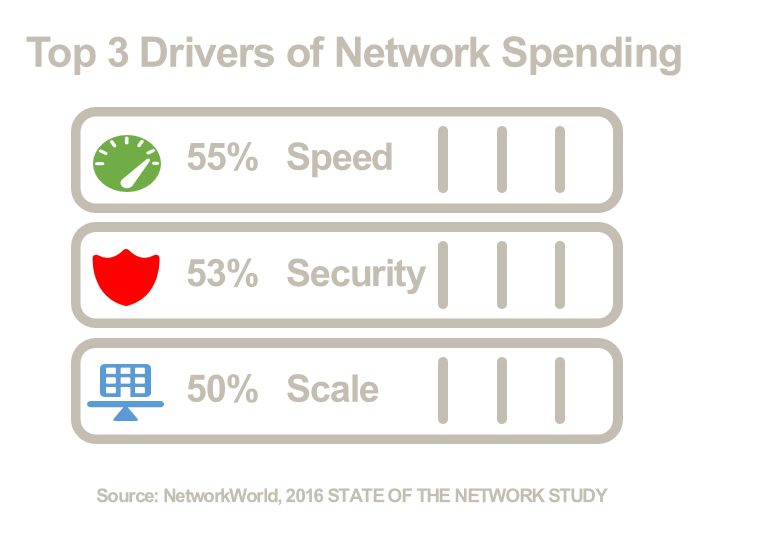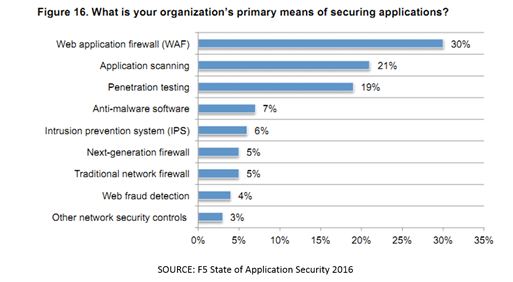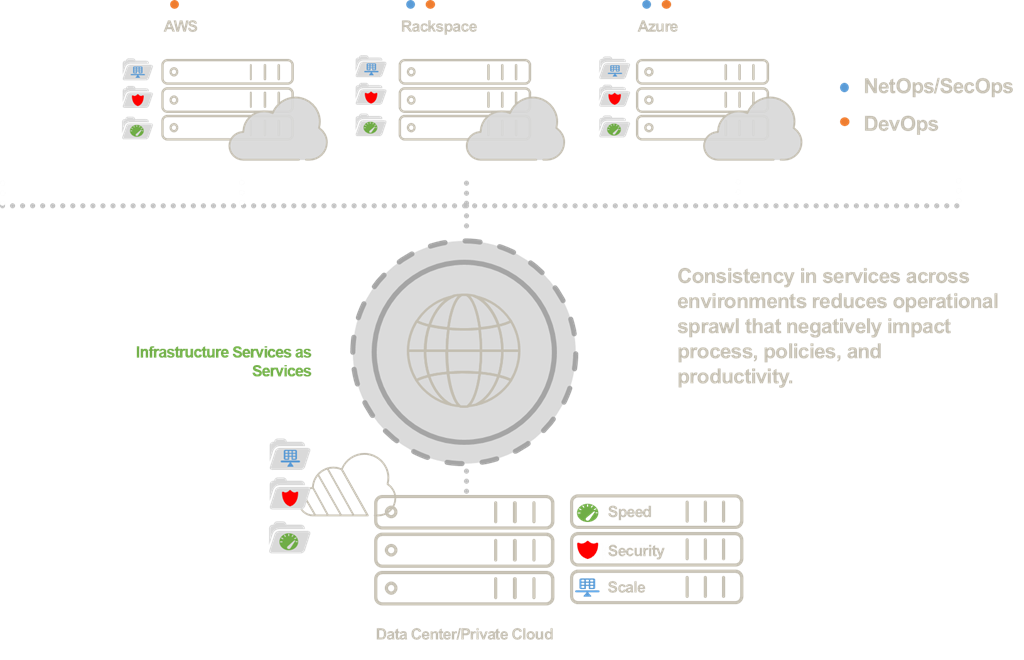自信を持ってリフト&シフト
クラウドは成熟期を迎えたと多くの人が同意するだろう。 パブリック クラウドは、時には警戒しながらも注意深く見守る私たちの監視の下で成熟し、2015 年秋に実施されたハーバード ビジネス レビューの調査では、回答者の大多数が「自社の組織では、少なくとも一部の新しいアプリケーションに対してパブリック クラウド ファースト戦略を採用している」と回答しています。 実際、クラウドファースト戦略は重要ではないと答えた調査回答者はわずか 22% でした。」
私たち自身の調査でもそれが裏付けられています。 2016 年のアプリケーション配信の現状に関する調査では、回答者の 67% が「クラウド ファースト」組織であると認識し、3 つのクラウド モデル (プライベート、パブリック、SaaS) が上位 5 つの戦略的トレンドを占めました。
しかし、クラウドに関しては依然として躊躇が残っていることに気づくでしょう。 長い間パッケージとして購入され、オンプレミスで導入されてきたコモディティ化された業務運用ソフトウェアの大部分を事実上消費した SaaS が驚異的な速度で成長する一方で、パブリック クラウドは遅れをとり続けました。 パブリック (AWS、Azure、Google、Rackspace)、プライベート (オンプレミス)、SaaS の使用を区別するよう求められた場合、「クラウド」の採用で主流となっているのは SaaS とプライベート クラウドであることが明らかになったのは、当社独自の調査だけではありません。 非公開です。
これにはさまざまな理由があり、前述のハーバード ビジネス レビューの調査では、ビジネス クリティカルで長期間使用されるアプリケーションに関しては、企業がパブリック クラウドに真っ先に飛び込むことに消極的であり、統合が大きな課題であると指摘しています。
しかし、ビジネスリーダーの「クラウド化」への欲求を妨げているのは、アプリケーションとデータソース間の統合だけではありません。 多くの場合、アプリケーションの速度、セキュリティ、スケールを提供するアプリ サービスへの統合、つまり依存関係が障害となります。

パブリック クラウドは成熟しつつあり、成長を維持するために IP テーブル ベースのファイアウォールや従来の負荷分散よりも高度なサービスを提供しなければならないという転換点にようやく達し始めています。 これは避けられないことでした。 価格競争が終わり、コンピューティングが 8TB のフラッシュ ドライブよりも安くなると、プロバイダーは差別化を図り、自社のプラットフォームを採用する説得力のある理由を提供するための他の方法を模索する必要がありました。 ネットワーク投資が速度、規模、セキュリティに重点を置いていることは注目に値します。 Network World のネットワークの現状調査の回答者は、「ネットワーク投資の主な推進要因は、ネットワーク速度とパフォーマンスの向上 (55%)、データ セキュリティの向上 (53%)、可用性の確保 (50%)、ビジネス継続性の確保 (46%)、IT プロセス効率の向上 (43%)、ビジネス プロセス効率の向上 (41%) である」と述べています。
スピード。 安全。 規模。
問題は、プロバイダーがそれらのサービスを提供しないということではなく、彼らは提供しており、今後も提供するだろうということです。 しかし、これらのサービスはデータセンターの運用システム、モデル、プロセスから切り離されたままであり、スタッフだけでなくスキルにも大きな変更が必要です。 ポリシーは、あるサービスから別のサービスに変換する必要があります。 プロセスとシステムが変更され、クラウド コンソール、ダッシュボード、ログ、API が含まれるようになり、ますますデジタル化が進むビジネスを日々管理するために必要な可視性が運用に提供されるようになりました。

これは、クラウド内で補完的なサービスが利用できることを前提としています。 弊社の最初の年次アプリケーション セキュリティの現状レポートでは、回答者は、進化する脅威の状況から保護および防御するために、さまざまなセキュリティ サービスに依存していることを示しています。
Web アプリケーション ファイアウォール、マルウェア対策、IPS、ファイアウォール、Web 詐欺検出。 それらはすべて、程度の差こそあれ、そこに存在します。 規模とスピードを提供するサービスも同様です。
組織がクラウドへの移行について話し合うとき、選択肢はほとんどありません。 アプリケーションの書き直しは、特に既存のアプリケーションのバックログを考慮すると、非常にコストがかかり、時間がかかります。 PaaS プロバイダーの OutSystems が指摘したように、このバックログは調査対象企業の 85% に影響を与えました。 半数以上が 10 ~ 20 個のアプリのバックログを抱えていると主張しました。
ただし、リフト アンド シフトでは、アプリケーションのサポート インフラストラクチャに関して当然の懸念が生じます。 アプリ コンポーネントだけでなく、アーキテクチャ全体をリフト アンド シフトする必要があるため、このような移行作業に対する IT 部門の熱意が冷めてしまう傾向があります。 ツール、コンソール、ダッシュボード、ポリシー言語がばらばらになっていることで生じる運用コストは、企業が節約しようとしている時間とお金のかなりの割合を奪う可能性があります。
そのため、クラウド プロバイダーが提供する急速に普及しているアプリ サービスの機能や特徴を考慮するだけでなく、運用の一貫性を実現するソリューションが提供できるかどうかも考慮することが重要です。 機能の 80% は許容範囲内で、コストの 50% は望ましいかもしれませんが、管理コストを考慮すると、新しいスタッフ、新しいツール、および新しいサービスの統合、運用、管理に必要な追加の時間によって、それらの削減はすぐに無効になります。

それは業務の無秩序な拡大であり、良いことではありません。
安心してクラウドへリフト&シフトすることが可能です。 機能と運用の両方においてインフラストラクチャ サービスの同等性を実現することで、組織はさらに複雑なアプリケーションをクラウドに移行できるようになります。
自信を持ってリフト アンド シフトを有効にするには、次の点を考慮してください。
1. サービス。 特に、ポリシーが明確に定義されたセキュリティ関連サービスを移行する場合は、アーキテクチャの整合性を維持することが重要です。 新しいサービスを導入するには多額の投資が必要です。
2. 管理。 展開場所に関係なく管理できるサービスを優先します。 スタッフは 3 台目のモニターを設置することを正当な理由とみなすかもしれませんが、ダッシュボードは 1 つだけの方が多くのダッシュボードよりも望ましいです。
3. オートメーション。 自動化とオーケストレーションの API とプログラムによる方法を評価し、運用スキルセットとの適合性を確認します。 さらに別の言語、フレームワーク、またはポリシー ツールセットが必要になると、学習曲線が導入され、エラー、緩いポリシー、および意図しない結果が発生する可能性があります。
あらゆる調査によると、クラウドに移行しています。 確かに、パブリック クラウドを経験することのないアプリケーションもいくつかありますが、経験するアプリケーションも多数あります。 今後の成功の秘訣は、アーキテクチャと運用の一貫性です。
これを念頭に置いておけば、すぐに自信を持ってクラウドへの移行と移行を行うことができます。
